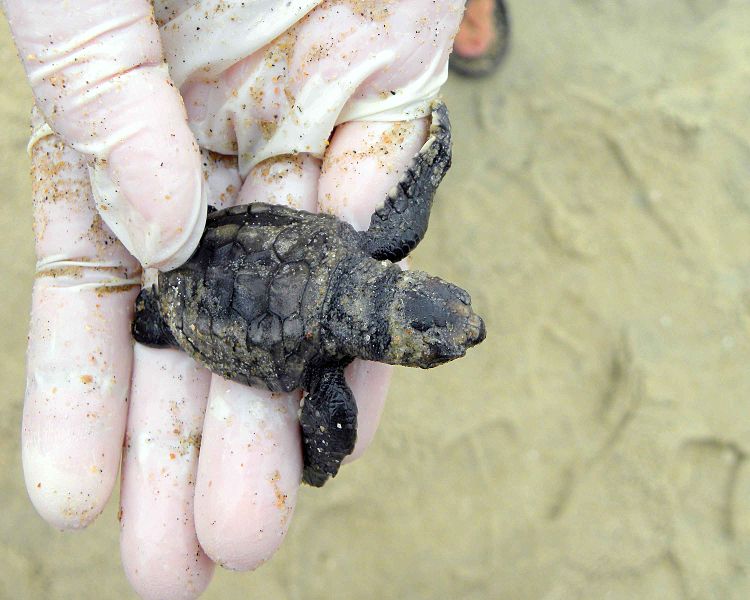In a show of environmental leadership, Costa Rica led an international effort that secured the inclusion of fishery guidelines that directly favor the regional conservation of leatherback sea turtles, during the Third Conference of the Parties COP III of the Interamerican Convention for the Conservation and Protection of Sea Turtles CIT, held last September 26 to 28, in the city of Mazatlan, Mexico. Leatherback sea turtles in the Eastern Tropical Pacific region are threatened with extinction in large part due to unsustainable longlining and gillnetting. Environmentalists welcomed Costa Rica’s leadership and are urging greater regional cooperation among nations to protect marine resources.
According to Randall Arauz, of the Costa Rican environmental organization PRETOMA and Central American Director of the Sea Turtle Restoration Project, leatherback sea turtle migration routes are well known in the Eastern Pacific, yet a lack of actions to grant leatherbacks the protection they deserve at the high seas from industrial fishing operations has prevailed. “For the first time ever, the importance of implementing conservation measures on the high seas in a regional context has been acknowledged,” explained Arauz. “This is an important first step and we urge other nations in the region to partner with Costa Rica in protecting the sea turtles and the Pacific.”
During the discussions pertaining to the Fisheries Resolution “Reduction of the adverse impacts of fisheries on sea turtles”, the COP III approved a series of guidelines for fisheries, among which are three of great relevance for the conservation of leatherback sea turtles:
• Avoid interaction between sea turtles and fishing operations, through temporary closures to fishing in particular regions, during the seasons in which there are high densities of turtles.
• Identify/Research the location of protected areas and/or closure periods that cover areas of critical importance for populations, and prioritize the cases of endangered species such as; Dermochelys coriacea, Eretmochelys imbircata and Lepidochelys kempii, and implement the closures outlined here.
• Study the possibility of establishing the maximum permissible incidental capture of individual sea turtles by species (specify fishery, species, geographic areas).
While these guidelines were established, approved and recommended by the CIT’s scientific committee last June, the consultative committee, a separate operative structure of the CIT, suddenly decided to eliminate such guidelines. As a result, during the COP III, some countries favored the elimination of the guidelines, and their substitution for more general guidelines, that do no make specific reference to the leatherback crisis.
Fortunately, Costa Rica, assuming a position of environmental leadership, called on the parties to keep guidelines as submitted by the scientific committee, and was joined in this call by the Dutch Antilles, Honduras, Belize, and the United States. As a result, the COP III decided to keep the original guidelines, as technical elements that offer support to the Parties for taking actions or adopting of strategies that reduce incidental capture of sea turtles due to their interactions with different fisheries.
Marco Vinicio Araya, the Costa Rican delegate to the COP III, said these guidelines will favor regional conservation processes. “Our country has been working very hard to consolidate a Biological Marine Corridor in the Eastern Tropical Pacific, and these guidelines will serve as a base to establish efficient conservation policy for leatherback sea turtles in a regional context,” he said.
“For several years now our attention has focused on the eastern Pacific leatherback crisis, and how industrial fishing has caused the dramatic decline of their populations”, explained Didiher Chacón, of the regional environmental organization WIDECAST. “These guidelines will facilitate the generation of information that could eventually lead us to a sustainable fishery in the region,” said Chacón.
The leatherback sea turtle (Dermochelys coriacea) is one of the largest reptiles in the world. Leatherbacks formerly nested abundantly along the Pacific coast of Central America. Unfortunately, their populations have declined dramatically. In the Pacific, their populations have been reduced up to 90%, mainly due to overfishing. In the Eastern Pacific the species could become extinct within the next decades.
CONTACT: Randall Arauz
TEL: +(506) 241-5227
FAX: +(506) 236-6017
info@tortugamarina.org
PRETOMA (Programa Restauración de Tortugas Marinas) is a Costa Rican non-profit, non-governmental, marine conservation organization that works to promote sustainable fisheries and protect sea turtles, sharks and marine biodiversity. PRETOMA is a member of the IUCN (International Union for the Conservation of Nature), WSPA (World Society for the Protection of Animals) and FECON (Costa Rican Conservation Federation).




